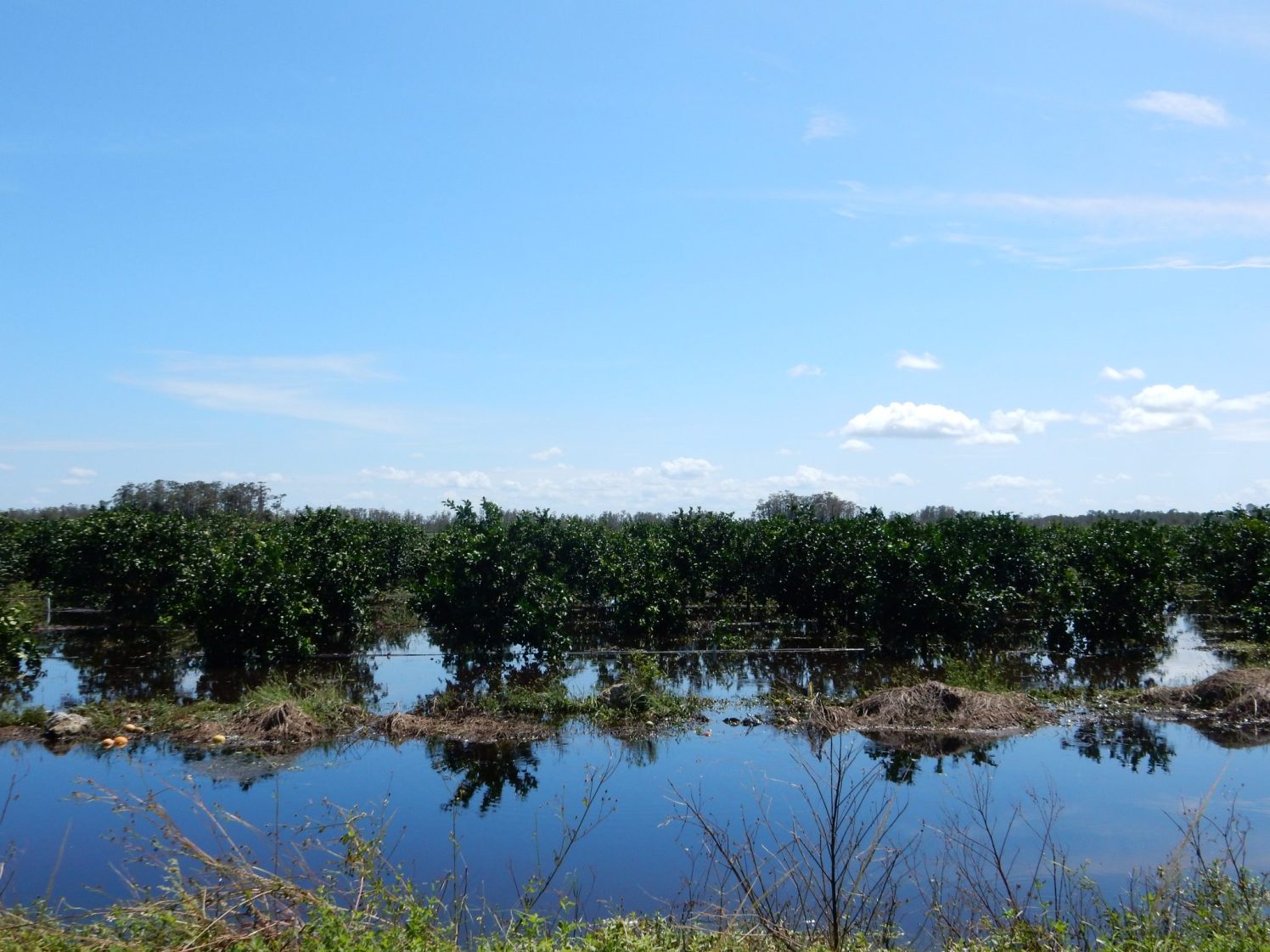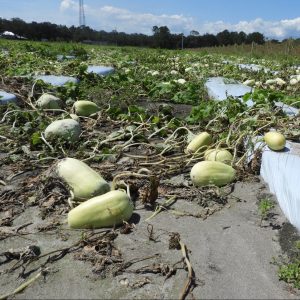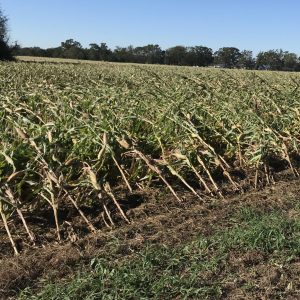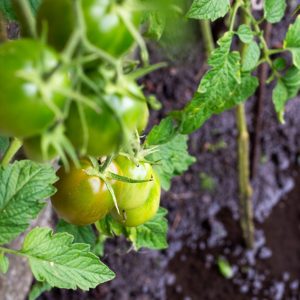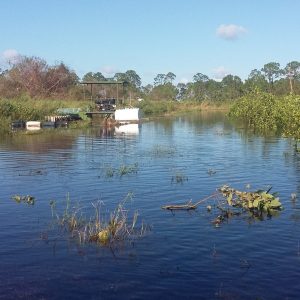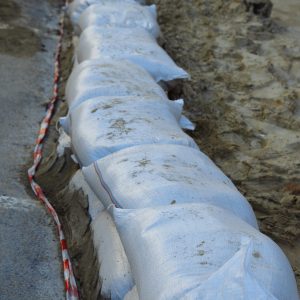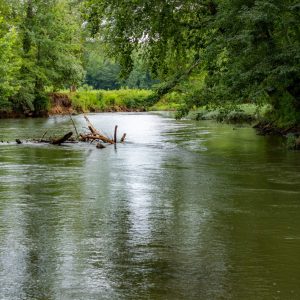Crop Production

Learn about floodwater, risk assessment, contaminated crops, and what food crop producers can do to prepare for flooding.
Throughout the Gulf Coast states, floods directly affecting food production (including produce, grains, and animal feed) are relatively rare. Preparing for or reacting to flooding in terms of keeping food safe is not something that is typically planned for. Food crop producers should understand and develop a proactive plan to respond to flooding.
What is floodwater?
In terms of food safety, it is important to understand that not all standing water in a field is considered floodwater. Flooding is considered the flowing or overflowing of a field from open bodies of water outside the food crop producer’s control. Events that lead to pooled water or excess standing water in a field, such as rain or a problem with an irrigation system, are not considered flooding.

Gene McAvoy
The reason for this difference is that floodwater may contain any number of different unknown hazards including sewage, chemicals, heavy metals, pathogenic (disease-causing) microorganisms, or other contaminants. In the case of pooling water where the source of the water is known, the risk of contamination is lower. This water may be subject to the provisions of the Food Safety Modernization Act (FSMA) Produce Rule.
What happens if the crop touches floodwater?
Flood events can pose a significant public health risk. Even if a crop is not completely submerged, there is potential for microbial and chemical contamination. Mold or toxins may develop even after the water has receded.
In many ways, the most straightforward flooding scenario for a food producer to react to is when floodwaters directly touch the crop. In this case, all food crops the floodwater has touched, either in the field or stored in bulk, are considered adulterated under 02(a) (4) (21 U.S.C. 342(a)(4)) of the Federal Food, Drug, and Cosmetic Act and should not be used for human or animal food. This includes root crops grown in fields submerged by floodwaters. The definition of adulterated means to make something poorer in quality by adding another substance, typically of inferior quality. While the official definition of adulterated food by the US Food and Drug Administration (FDA) is more than a page long, in the context of flooding it can be briefly defined as “it bears or contains any poisonous or deleterious substance which may render it injurious to health…”.
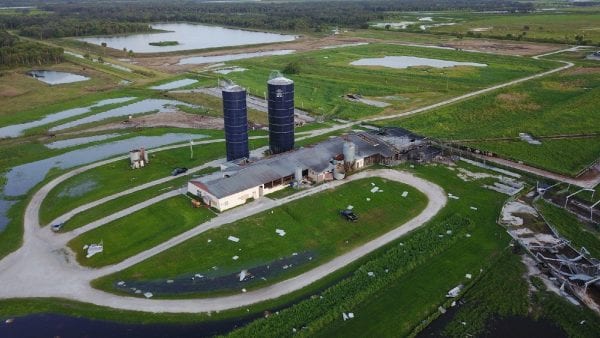
Gene McAvoy
Assessing Risks When Floodwaters are Present But Do Not Contact the Crop
How can safety be assessed if it is not clear if the floodwater contacted the crop?
Sometimes it is difficult to determine whether the crop was in contact with the floodwater (and has become adulterated). When growing an underground crop, producers might assume that the crop did not touch the floodwater; however, according to the FDA, these crops are considered adulterated or unfit for harvesting. An assessment of the potential effect of the flood on the crop will need to be conducted. If it is determined that the crop did not come in contact with the water or the wet soil, it may be harvested if it is possible to do so without contamination. It is important to consider all types of potential contaminants linked to flooding (chemical hazards, such as heavy metals and toxic agrochemicals, or biological hazards, such as bacterial pathogens, parasites, and viruses). Mold growth and the possible formation of mycotoxins (e.g., aflatoxin, fumonisin, vomitoxin, ochratoxin, patulin) are significant concerns when prolonged hot humid conditions prevent the drying of grain in the field or the rewetting of grain during storage.
A thorough assessment of the potential hazards includes the following:
Evaluation of the potential contaminants in the floodwater
- Were there any animal farms in the vicinity? Did runoff from these operations reach the growing area?
- Did the flood occur soon after applying pesticides that need a specific time between application and harvest?
- Were any industrial buildings or oil refineries in the vicinity? These facilities are common in Gulf Coast states and have the potential to leak contaminants into floodwaters during a flood.
- Was floodwater stagnant or not flowing for long periods of time? Even if there is potential for dilution of the contaminated water with water from clean sources or rainwater, small amounts of pathogens will likely survive in the standing water that is in contact with soil and plant debris.
Development stage of the plant at the moment of the flood
- If the harvestable part of the crop has not yet developed, the crop may be safe to harvest since the likelihood of contamination is lower. The possibility of contaminants being taken up through roots is discussed in the next section.
Type of crop
- Crops that are tall and their harvestable portions are at a level well above the ground may not have been submerged or in contact with the floodwater. The likelihood for the harvestable portion of the crop to be covered by floodwater is lower in fruits growing on trees, such as avocados, mangoes, and citrus. Even shrubs that are not as tall, such as tomatoes, can be tall enough that the lowest part of the harvestable portion did not touch the water. In these cases, it is important to assess the potential for contamination through splashing and filtration.
Evaluation of the likelihood that splashing has contacted the harvestable portion of the crop
- Food crop producers need to assess the likelihood that splashing has occurred and contacted the crops. In general, the farther the harvestable portion is from the water, the lower the risk of contamination from splashing. Heavy rainfall during flooding events is likely to cause splashing. Water movement from rescue boats, water being pumped, or waves made by animals or wind may be powerful enough to contaminate harvestable portions that are above the flood line.
Evaluation of the likelihood that the crop has been exposed to chemical contaminants or pathogens
- In some cases, contaminated waters from nearby areas that are flooded may flow or leach into irrigation water sources and potentially contaminate crops in fields that were not flooded. Food crop producers need to assess the likelihood for this to occur in their fields.
An error in determining whether the crop contacted floodwater can result in the harvesting of an adulterated crop with the subsequent risk of illness if the produce was contaminated and is consumed.
Can the plant uptake contaminants through the roots?
If contaminants are transferred to the soil by the floodwaters, food crop producers need to evaluate the possibility that chemical or biological contaminants in the soil migrate to the harvestable portion of the crop that did not come in contact with the floodwater.
- Chemical contaminants. The uptake of chemicals, such as heavy metals and other toxic elements from polluted soil to edible plants, has been well documented. However, the sole presence of a chemical contaminant in the soil does not imply that the contaminant will absolutely be taken up by the plant. The chemical form of the heavy metals and other organic or inorganic pollutants determines their solubility and therefore their ability to undergo uptake by vegetable plants. Studies on the variability in uptake among vegetable types show that leafy greens have the greatest potential to accumulate heavy metals, followed by root vegetables and legumes. Request a chemical assessment of the soil to determine its potential for chemical uptake.
- Microbial pathogens. The ability of pathogens to internalize fruits and vegetables before harvest is uncertain. Some published studies indicate that the internalization of pathogens such as E. coli O157: H7 is possible in spinach or lettuce leaves through stomata or physical blemishes on the plant. In contrast to chemicals, microbes, including viruses and bacteria, are unlikely to be absorbed. There are few reports of colonization of roots resulting in the appearance of pathogens in the leaves and flowers of the plant. Nevertheless, the information from these laboratory-conducted studies is inconsistent and insufficient to indicate whether human pathogenic bacteria could contaminate the harvestable portion of a crop by being taken up by the plant through the roots. A more plausible scenario would be the presence of true plant pathogens infecting the roots and shoots of the plant, and the human pathogens piggy-backing to be taken into the plant. Until data confirms a scientific answer, the possibility of pathogens to undergo plant uptake is only a theory and should not serve to create unfounded concern.
To quote the FDA guidelines for evaluating the safety of produce from fields that were affected by floods, the likelihood of contamination is low if:
- “The edible portion of the crop has developed after the floodwater receded,
or
- The lowest edible portion of the crop was above the floodwaters level with minimum risk of contamination due to splashing;
and
- The crop can be harvested without cross- contamination from nearby environment, including flooded soil and flooded portion of the crop.”
Livestock Movement through Food Crop Growing Areas
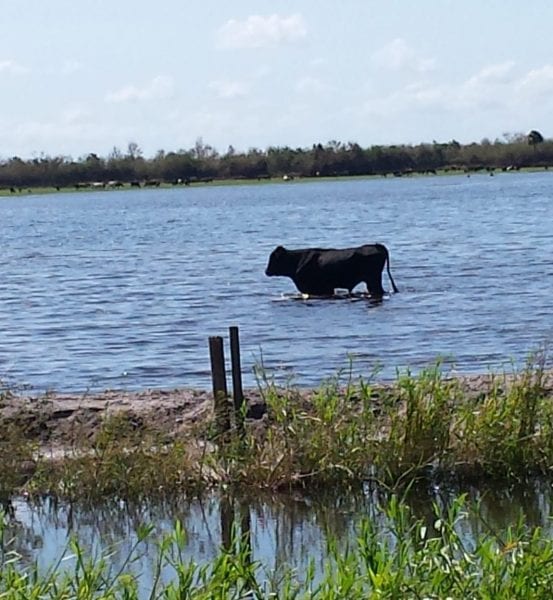
Gene McAvoy
Can crops be contaminated by the movement of livestock during a flood?
The movement of livestock animals, prior to an impending flood event, during the flood/storm event itself, or during their return to designated lands, may result in food safety concerns for food crop producers, specifically as it relates to production field management.
In advance of severe thunderstorm activity or large area floods produced from excess rain or storm surge, livestock or other food animals should be relocated to higher ground or other safe holding systems. Preferably, livestock owners located upstream of or adjacent to crops will have sufficient warning to evacuate food animals without having to move over production fields.
However; if that is not possible, food crop producers should be made aware of domestic livestock movement through fields. Ranchers needing to move herds quickly should contact food crop producers and alert them to the potential for animals being moved through crop fields prior to the onset of flooding. Alternatively, ranchers may notify Cooperative Extension or the County Sheriff Livestock Officer. These contacts can help transmit information to food crop producers. Should flood damage ultimately be less extensive than what is anticipated, the food crop producer should assess the field for the presence of animal excrement on soils or crops according to the FSMA Produce Safety Rule.
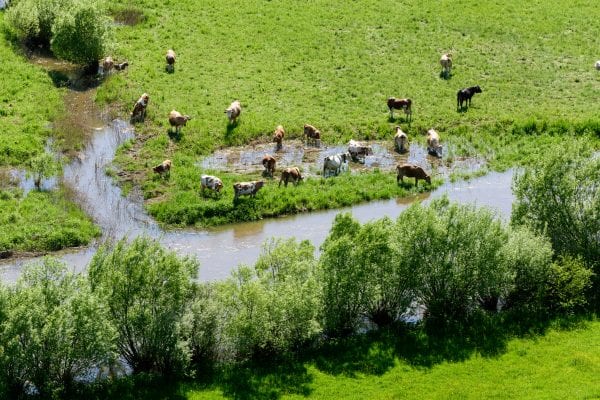 Livestock presence in flooded fields, even if transient, introduces the risk of human pathogens being shed in animal feces. As floodwaters subside and livestock are removed from production fields and returned to animal production operations, food crop producers need to assess the safety of the soil and groundwater sources by having these tested for generic E. coli and other hazards.
Livestock presence in flooded fields, even if transient, introduces the risk of human pathogens being shed in animal feces. As floodwaters subside and livestock are removed from production fields and returned to animal production operations, food crop producers need to assess the safety of the soil and groundwater sources by having these tested for generic E. coli and other hazards.
In the event that animal carcasses are discovered in crop fields following flooding as waters recede, food crop producers should contact Cooperative Extension or emergency management in their area for guidance on carcass retrieval and/or disposal. Animals that die during flooding may serve as a source of human and/or animal pathogens. These pathogens may contaminate crops that are sown into the soil if the carcass is not promptly and properly disposed of. This may produce an added hazard for food crop producers during subsequent field reconditioning and crop planting activity.
Crop Disposition
What should be done with crops contaminated by floodwaters?
Because crops exposed to floodwaters are considered adulterated, FDA recommends that these crops be disposed of in a manner that ensures they are kept separate from crops that have not been flood damaged to avoid adulterating clean crops. There could be health implications or legal issues if a person consumes the product or feeds it to livestock, so it must be disposed of in a way that ensures that it will not enter the food chain. With grain and some produce crops, the easiest course of action may be to till it into the soil once the field has drained. Tilling in this organic matter can also help speed recovery of the soil for replanting. Unsalable tree fruits may be able to stay in the orchard to decompose.
Food crop producers should keep in mind that local regulations may dictate how the product should be disposed of. The state department of agriculture, emergency management, and environmental protection agencies are good resources to help determine how to properly dispose of unsalable product that cannot be left in the field.
In cases where only part of a field was flooded, the solution may be more complex. It may be difficult to develop a plan for how to remove affected crops before damages are assessed. Factors to consider include the following:
- Will harvesting occur while floodwater remains in the field?
- If the contaminated crop is disked under or mowed down prior to harvesting the salvageable portion, will the salvageable portion become contaminated by this activity?
- Can the no-harvest area be effectively flagged off?
- If the no-harvest area is simply flagged off, how can it be assured that the crop will not enter a human food channel (i.e., through gunny sacking or pin hooking)?
- What documents should be kept to justify the decision, show the course of action, and provide a record that the crops did not enter a human food channel?
- Gene McAvoy
Does there need to be a buffer zone around adulterated crops?
While evaluating crops that may have been adulterated, a buffer zone beyond the high water mark in the field may be needed. For example, a buffer zone is needed if there is a possibility of water moving subsurface beyond the high water point that may affect the crop.
A buffer zone is also needed if equipment needs to move between fields during a harvesting activity so the flood-affected area can be avoided. The exact size of a buffer zone will need to be determined on a case-by- case basis. For example, the California Leafy Greens Marketing Association indicates a minimum 30-foot buffer beyond the high water mark to allow equipment an adequate area to turn outside of the flooded area.
Why can’t the affected crops be sent for processing or some other treatment?
Because they are labeled adulterated, there is no practical method of reconditioning the crop that will provide a reasonable assurance of food safety. In short, no treatments exist to decontaminate the adulterated products.
Options such as sending the crops to a processing facility that would apply a thermal kill step (e.g., canning, pasteurizing), or even a process like irradiation, seem reasonable to remove the microbial hazards. However, it is important to remember the definition of floodwater, and that the microbial hazards are not the only concerns. While these processes will remove some microbial hazards, they are not designed to remove chemical hazards or to handle the microbial loads that may be present in raw sewage.
Can adulterated crops be reconditioned to animal feed?
FDA is very clear that adulterated crops cannot enter human food channels. However, in the case of fresh fruits and vegetables, if they have not begun to spoil due to lack of refrigeration or for other reasons, they may be considered for diversion to animal feeds under certain circumstances. FDA and the state department of agriculture will work with producers on a case-by-case basis to recondition an adulterated crop into animal food. FDA has extensive information on reconditioning food to animal food that can be found on the FDA website.
Requests for reconditioning the crop to animal feed should be directed to the FDA public affairs specialist located at the closest FDA field office. At a minimum, before contacting the FDA, the product should be tested for mold and mycotoxins, heavy metals, pathogenic bacteria and their toxins, and chemical contaminants such as pesticides. More information about testing can be found on the FDA Animal Feed website.
What can be done with product that has been damaged, but not exposed to floodwaters?
Although food crops that are exposed to floodwaters cannot be sold as food for humans or animals, crops that are damaged by wind or hail could be diverted to a secondary market. In the case where a flood is imminent, certain crops can be harvested early and diverted to an alternative market. Having a secondary market established can save some time and money during an emergency. Factors to consider include the following:
- The labor that might be necessary to harvest prematurely or hand harvest damaged product. Sometimes the increased labor cost will offset the income generated.
- Identifying potential processors that are not in the same geographic area as the farm since operations close by may be damaged or without power.
- Whether damaged product going to a secondary market can be removed from the field without contaminating other products or equipment that will be used to harvest for a fresh market. Sometimes it may be safer to leave product in the field.
- Pickling plants, especially those supplying specialty markets, may be interested in premature fruits and vegetables such as green strawberries and tomatoes.
- Processors, in particular, jam and jelly processors, may be interested in premature or damaged fruits.
- Winemakers that serve specialty markets may be interested in damaged fruit.
Can grain from a flooded bin be salvaged?
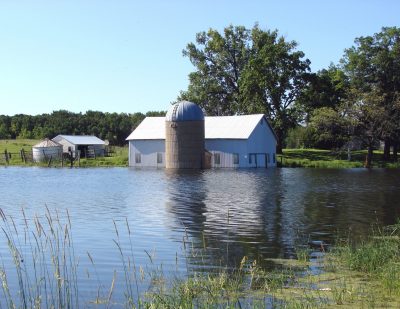 If a grain bin is flooded, it may be possible to salvage the portions above the water immersed grain. Typically, moisture will not travel more than a foot above the flood line. To prevent cross-contamination, salvageable grain must be removed from the top or side, not down through the contaminated grain. All the salvageable grain must be removed before doing anything with the contaminated portion. Aeration fans should not be started on flooded bins because this could spread mold or other contamination throughout the salvageable grain. Conveyors and pits under bins are likely to contain floodwater as well as rotting grain and will need to be cleaned before use.
If a grain bin is flooded, it may be possible to salvage the portions above the water immersed grain. Typically, moisture will not travel more than a foot above the flood line. To prevent cross-contamination, salvageable grain must be removed from the top or side, not down through the contaminated grain. All the salvageable grain must be removed before doing anything with the contaminated portion. Aeration fans should not be started on flooded bins because this could spread mold or other contamination throughout the salvageable grain. Conveyors and pits under bins are likely to contain floodwater as well as rotting grain and will need to be cleaned before use.
Moldy grain will not always contain mycotoxins, but the presence of considerable mold growth on grain in itself may reduce digestibility, weight gain, milk production, and disease resistance. Producers considering feeding moldy grain to livestock should test for mycotoxins and consider the reduction in feed quality. When testing, it is important to take representative samples since mycotoxins can be present in very small quantities and can occur only in isolated spots even when there is mold throughout the bin.
FDA allows for reconditioning in cases where the floodwater did not remain long and in the rare situation where it is known that the water did not contain contaminants. FDA has provided a series of questions and answers related to salvaging grain from flooded fields to help producers make informed decisions.
In addition to being a food safety hazard, moldy grain can be a worker safety hazard from airborne mold spores, which contain allergens and/or mycotoxins, and can pose health threats. Workers should wear protective equipment to prevent breathing in toxins whenever removing moldy grain from storage. Purdue Extension has more information on the safe handling of moldy grains.
Flooding Impacts on Water Sources
How does flooding impact surface water?
The Gulf Coast region has experienced frequent flooding events within the past few decades resulting in contamination of surface water with microbial and chemical hazards. As floodwater contacts sources of contamination, such as human sewage, animal waste, and industrial waste, it picks up and carries contaminants and subsequently introduces them into other water sources. Contaminants may infiltrate through porous and permeable soils and reach groundwater. Floods may cause leakage of waste from underground septic tanks resulting in effluent contamination in surface water.
What types of microbial contamination could be in surface water?
High levels of fecal indicator bacteria and microbial pathogens were observed in floodwaters in New Orleans following hurricanes Katrina and Rita. The type and concentration of microbial pathogens in floodwater are dependent on factors such as human and animal activities in the vicinity of the flood area and the source of contaminants. The microbial contaminants include bacteria, viruses, protozoa, and helminths. Agricultural operations, rural septic systems, industrial sewage systems, and raw manure or feces are the prominent sources of microbial contamination. Frequently reported bacterial pathogens in floodwater include E. coli O157:H7, Salmonella, Vibrio, Campylobacter, fecal Streptococcus, and Enterococcus. The viral contaminants include norovirus, enterovirus, rotavirus, and hepatitis virus. Presence of human parasitic protozoans such as Giardia and Cryptosporidium has also been reported. In 2016, 15 wells were tested in Louisiana after flooding events; all of them were positive for E. coli. The floodwater produced by Hurricane Harvey in 2017 had 125 times higher level of E. coli than is considered safe for swimming in the Houston area.
What types of chemical contamination could be in surface water?
A wide variety of chemical contaminants can get into floodwaters and contaminate surface waters. Heavy metals, petroleum products, and pesticides are commonly reported chemical contaminants. Additionally, floodwaters have the potential to carry mycotoxins. The type and concentration of chemical contaminants depend on factors such as the level of the flood, proximity to chemical operations, and the soil composition in the flooded area. Some heavy metals (lead, chromium, mercury) have a high affinity to inorganic particles such as suspended solids or river bed sediments. This characteristic may help increase the concentration of these contaminants in floodwater. Studies have shown an increased concentration of heavy metals after flooding. Localized catastrophes such as petroleum leaks and chemical spills due to flooding are another route of chemical contamination. The level of organic compounds may increase during flooding events. The decomposition of organic compounds such as fertilizers can increase concentrations of nitrate and phosphate. The nutrient enhancement of water with nitrate and phosphate may result in the production of toxic compounds through chemical reactions or microbial actions. In addition, organic compounds may help with survival and growth of microbial pathogens in surface water.
After flooding, assessment of microbial and chemical quality of surface water is necessary before using the water for agricultural purposes. The use of contaminated water for irrigation and other pre-harvest activities will increase the risk of microbial and chemical contamination. Even when using an irrigation system without direct contact with the harvestable portion of the crop, chemical contaminants from water may leave the residues in farmlands for an extended time.
- Gene McAvoy
How can surface water sources be protected before a flood?
A sustainable method to minimize the risks associated with contamination from runoff water is to plant vegetation around the surface water source. A buffer zone such as a vegetative filter strip (VFS) is one of the methods applied to minimize surface water contamination through agriculture runoff. A VFS includes a variety of grass and forage species located at the downslope from the potential source of contaminants and upslope from an area being protected. Having buffer strips near a surface water source will protect water quality by reducing the level of physical, chemical, and microbiological contaminants that reach the surface water source. Sandbagging and the construction of berms are other common ways to divert floodwaters and prevent them from contaminating surface waters but may be subject to state and local regulations. The eXtension website (https://www.extension.org) contains valuable information on the proper materials to use for sandbags, the filling of sandbags, construction of dikes, and other considerations for the most successful floodwater diversion.
The EPA’s Section 304(a) provides the information on qualitative and quantitative measurement of the pollutants from surface water that may affect human health and aquatic life. For recreational waters, E. coli and enterococci are used as indicators of fecal contamination. All waters shall be free from waste discharges or other contaminants. The local or state health department or Cooperative Extension can help in assessing the quality of the surface water and disinfecting water sources after flooding events. The EPA recommends identifying potential contaminants and associated risks posed by flooding on a case-by-case basis. This may involve identifying any possible upstream contributors of human pathogens and chemical contaminants; determining factors that may influence microbial level, growth, and survival; and intended use of contaminated water.
How does flooding impact groundwater?
The obvious threat to groundwater is the potential for microbial and chemical contaminants to enter through a flooded wellhead, but groundwater can still become contaminated even when the wellhead itself is not flooded, such as through saturated septic drain fields. At a minimum, agricultural water should be tested for generic E. coli after a flood or major storm event. Cooperative Extension and the county health department can provide information on region-specific contaminants. The EPA has also identified conditions in local water systems that may cause a producer to want to test for additional contaminants. After a storm, debris lines and water stains can help indicate if the wellhead was flooded. If the well itself was flooded, be cautious around electrical connections. Wait until all electrical connections outside of the well casing are dry before trying to restart the well. If the well was not sufficiently sealed before the flood and water intruded into the casing, steps will need to be taken to flush out and disinfect the well. If water is muddy or mud and sediment entered the well, contact a well driller to pump out the debris. Refer to the Centers for Disease Control and Prevention for guidance on disinfecting and flushing out wells after a flood.
How can groundwater sources and wells be protected before a flood?
Not all wells are created equally and even soundly- constructed wells in low lying areas may be subject to flooding. Drilled wells present the lowest risk and are generally constructed with a deep metal, plastic, or concrete pipe casing that extends 1 or 2 feet above the surface (or above the highest recorded flood line). Wells should be sealed between the drilled hole and the casing with injected bentonite clay, neat cement (without aggregate) or grout to prevent surface or floodwater from running down the casing into the well. The surface around the sealed well casing may be curbed in cement which may provide some additional protection from surface runoff. The casing (pipe) should also be capped with a sanitary well cap, which is often a tight-fitting cap that includes a protruding, screened vent facing downwards. Many newer drilled wells also feature a sanitary seal which is an additional tight-fitting rubber seal located within the casing just below the surface. Other types of wells, such as dug wells and driven (sand point) wells, are generally shallow and are more susceptible to contamination from flooding.
The same pollutants that can contaminate surface and floodwaters, such as sewage, heavy metals, pesticides, and fertilizers, can also impact groundwater. In preparation for a storm where flooding of a well is possible, shut off power to the well and install a watertight cap over, or in place of, the standard screened vent cap. If a watertight cap is not available, consider sealing the vent cap with a heavy plastic garbage bag with waterproof tape. Remember to reopen the vent cap prior to restarting the well. Move vehicles, tractors, pesticides, fertilizers, fuel, and other chemicals as far away as possible to prevent potential contamination of the well. Even in the absence of a flood event, a minimum setback distance of 50 to 100 feet from the well is often suggested or required for any source of pollution. Providing a greater setback distance and elevating pollutants above potential floodwaters should be considered when making preparations for flooding. For diesel-powered wells, consider the potential for fuel to contaminate floodwaters and take steps to reduce potential contamination, such as storing fuel in another tank away from the well if there is potential for heavy flooding. Wait until after the threat of a flood has passed before locating portable generators or fuel tanks near the well. Prior to shutting down the well, ensure that there is no potential for backflow into the well when the well loses pressure or when areas with faucets, hoses, or other irrigation lines may become flooded. This may include the use of backflow prevention devices. Note that atmospheric, or hose bibb, vacuum breakers do not function when flooded. Any abandoned wells on the property should be properly sealed by a licensed contractor.
How can contamination from septic systems be minimized?
Septic systems are often overlooked when considering food safety hazards. Some considerations should include repairing leaks that needlessly increase the volume of water impacting septic drain fields and keeping the area around the drain field protected from additional runoff. If a septic tank is reaching capacity, producers should try to pump it out before the rainy season or threat of a major storm and ensure that the septic system is still meeting demands for capacity of the operation. A recirculating sand fill in the septic system can also be used to mitigate risks from leaching or backups and provide an additional treatment step for wastewater before it reaches the drain field. The state department of public health is a good resource for advice concerning septic systems.
Flooding Impacts on Soil
Should soil be tested for heavy metal contamination after a flood?
Increased soil metal concentrations of arsenic, cadmium, lead, and zinc have been reported in agricultural lands following flooding. Potential heavy metal contamination is largely dependent on proximity to polluted areas. Heavy metal contamination in soils can be tracked to industrial wastes, mine tailings, wastewater treatment, pesticide applications, leaded paints, and many other sources. Cooperative Extension and the county health department may be able to provide information on region-specific contaminants. Heavy metals commonly tested by soil testing laboratories include arsenic, cadmium, chromium, copper, mercury, lead, and zinc. Soil samples for metal analysis can be collected in the same manner as agronomic soil test samples. It is helpful to compare these results to baseline results obtained before flooding or to nearby soil that did not experience flooding to assess the level of change. Contact a soil testing laboratory for specific instructions on soil sample collection and shipping.
Should soil be tested for pesticide residue contamination after a flood?
Since most pesticides degrade relatively quickly in soils, contamination with pesticide residue is unlikely to pose a long-term threat in flooded fields. However, pesticide contamination may be a risk if fields are in proximity to areas where large amounts of undiluted pesticides are stored. If pesticide contamination is suspected, contact the state pesticide regulatory agency to evaluate the risk associated with pesticide contamination and determine the best management strategy to reduce risk.
Public Soil Testing Laboratories in Gulf Coast States
| Alabama- Auburn University Soil, Forage and Water Testing Laboratory | Florida- UF / IFAS Analytical Services Laboratories | Louisiana- LSU AgCenter Soil Testing and Plant Analysis Lab | Mississippi- MSU Soil Testing Lab | Texas- TAMU Soil, Water and Forage Testing Laboratory |
|---|---|---|---|---|
| 961 S. Donahue Drive Auburn University, AL 36849-5411 | 2390 Mowry Road Gainesville, FL 32611-0740 | 104 Sturgis Hall Baton Rouge, LA 70803 | 190 Bost North Mississippi State, Mississippi 39762 | 2610 F&B Road College Station, Texas 77845 |
| Phone: (334) 844-3958 | Phone: (352) 392-1950 Ext. 221 | Phone: (225) 578-1219 | Phone: (662) 325-3313 | Phone: (979) 845-4816 |
| Email: soillab@auburn.edu | Email: soilslab@ifas.ufl.edu | Email: stpal@agcenter.lsu.edu | Email: soiltesting@tamu.edu |
How are plant-available nutrients affected by flooding?
Flooding can result in loss of plant-available nutrients through several pathways:
- Surface soil erosion can result in loss of valuable plant- available nutrients and organic matter.
- Nutrients that are prone to leaching, such as nitrate and potassium, can be lost to groundwater.
- Gaseous losses of nitrogen can occur in water-saturated soils through denitrification.
Agronomic soil testing is recommended following flooding to assess soil plant-available nutrient contents. After periods of prolonged flooding, phosphorus deficiencies can occur even if soil tests indicate adequate plant-available phosphorus concentration since flooding can reduce populations of soil microorganisms responsible for increasing availability of phosphorus. Supplemental nitrogen applications may be necessary to maintain production in cases where floodwaters have not contacted the harvestable portion of the crop and the producer wishes to salvage the crop. Both public and commercial laboratories can test for plant-available nutrient content.
How can fields be renovated after a flood?
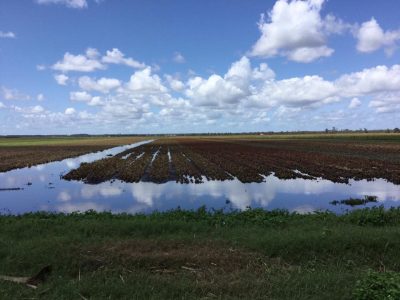
Gene McAvoy
Erosion, sediment deposition, and crop residue accumulation can leave agricultural fields in need of significant physical repair after a flood. It is extremely important to let soils drain prior to working in fields since operating equipment in saturated soils can cause severe soil compaction, which has a negative impact on soil water infiltration and crop growth. Large debris should also be removed from fields prior to reworking soil.
Crop residues or sediment deposits which have accumulated to less than 4 inches deep can be incorporated using conventional tillage methods. If sediments or residues have accumulated to a depth of 4 to 8 inches, deep tillage to twice the accumulation depth with a moldboard or chisel plow may be necessary. Formation of minor ditches or gullies from erosion may also be corrected with tillage. However, larger gullies or deeper sediment accumulation may require more extensive repair with earth-moving equipment. Contact the local NRCS office to determine if assistance programs are available to restore damaged farmlands.
Following field renovation, soil samples should be collected to determine fertilizer and lime requirements to restore crop productivity. If cash crops are not being planted immediately after field renovation, use a cover crop to protect the soil from further erosion. Since some soil microbial populations may be significantly reduced under flooding conditions, it is important to inoculate legume crops, such as soybean and peanut, with beneficial microbes following a flood event.
Should soil be tested for microbial contamination after a flood?
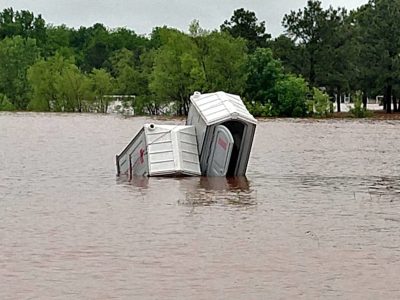 It is unlikely for plants to allow human pathogens to travel up through the roots and be deposited in fruits or other portions of the plant; however, floodwaters have the potential to contain any number of hazards including large amounts of human sewage and runoff from animal production areas. Comprehensive testing for pathogens is not recommended for all flooding situations, but if there is a reason to believe that the soil is heavily contaminated with human pathogens, food crop producers may want to consider microbial testing following a flood. If soil is going to be tested, a gradient of soil moving outwards from the flooded area could be tested to determine if detected pathogens are flood related or were present in the soil prior to flooding. FDA recommends that producers discuss their testing plans with state and local FDA regulators and technical specialists for case-specific evaluations. Depending on the circumstances, pathogens of interest might include the following:
It is unlikely for plants to allow human pathogens to travel up through the roots and be deposited in fruits or other portions of the plant; however, floodwaters have the potential to contain any number of hazards including large amounts of human sewage and runoff from animal production areas. Comprehensive testing for pathogens is not recommended for all flooding situations, but if there is a reason to believe that the soil is heavily contaminated with human pathogens, food crop producers may want to consider microbial testing following a flood. If soil is going to be tested, a gradient of soil moving outwards from the flooded area could be tested to determine if detected pathogens are flood related or were present in the soil prior to flooding. FDA recommends that producers discuss their testing plans with state and local FDA regulators and technical specialists for case-specific evaluations. Depending on the circumstances, pathogens of interest might include the following:
- Bacterial pathogens, such as salmonella, E. coli O157:H7, other Shiga toxin-producing E. coli, and Clostridium perfringens
- Viral pathogens, such as hepatitis
- Parasites, such as Cryptosporidium and Giardia
Unlike pathogens contaminating water sources, pathogens in the soil will usually die off rapidly over time when the soil is exposed to drying environmental conditions, fluctuations in temperatures, and a regenerating soil microbiome. Generally, a waiting period of 30 to 60 days before replanting is recommended to minimize the risk of pathogens persisting in the soil into the growing season. The public soil testing labs located throughout the Gulf Coast states may be able to conduct these tests or suggest a lab located nearby.
Key Resource
Local emergency management agencies work with the Environmental Protection Agency (EPA) and state environmental agencies to assess the release of hazardous substances into waterways. Each local agency keeps a local inventory of hazardous substances (Tier 2 list) that can be helpful in determining if soil should be tested for deleterious substances after a flood. The EPA and local agencies also work together to conduct testing and advise residents on the safety of water when a chemical release occurs.
Considerations for Organic Food Crop Producers
How does flooding affect organic farms?
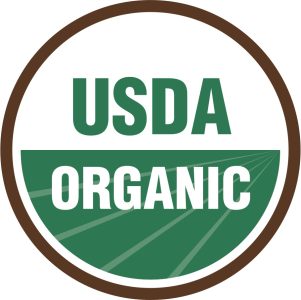 Flooding events may present a big challenge to organic food crop producers. The National Organic Program (NOP) requires that no prohibited substances have been applied or introduced to the crops or land for a period of 3 years immediately preceding the harvest if the crops are intended to be sold, labeled, or represented as organic. The prohibited substances include synthetic fertilizers, pesticides, herbicides, sanitizers, heavy metals, and microbial pathogens. The floodwaters may have the potential to introduce any of these chemical and biological contaminants onto organic farms.
Flooding events may present a big challenge to organic food crop producers. The National Organic Program (NOP) requires that no prohibited substances have been applied or introduced to the crops or land for a period of 3 years immediately preceding the harvest if the crops are intended to be sold, labeled, or represented as organic. The prohibited substances include synthetic fertilizers, pesticides, herbicides, sanitizers, heavy metals, and microbial pathogens. The floodwaters may have the potential to introduce any of these chemical and biological contaminants onto organic farms.
FDA considers crops that are exposed to flooded water as adulterated crops and these crops should not be sold for human consumption in any form. The same considerations that a conventional food crop producer would use to determine crop disposition, appropriate buffer zones, and wait time until replanting should be used. Sometimes, a farming operation will have to be changed after flooding events. If the changes affect the producer’s compliance with the organic requirement, the producers should immediately notify the organic certifying agent.
The NOP states that whenever a certifying agent finds a reason to believe that the product or an organic agricultural input has come in contact with a prohibited substance, they make pre-harvest and post-harvest testing a requirement. Under the NOP regulation §205.671, a crop that shows over 5 percent of the EPA tolerance for a given residue cannot be sold as organic. It is always a challenge to identify what to test for after flooding. Having knowledge of the activities around and upstream of the farm, such as sewage treatment facilities, crops grown, and fertilizers and pesticides used in neighboring farms, will give the food crop producer an idea of the prohibited substances that are more likely to be present.
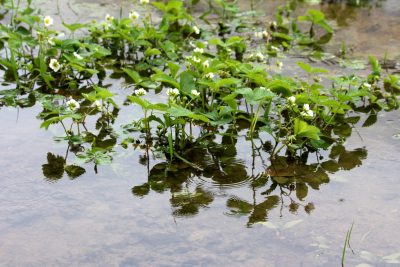 After flooding, food crop producers may have to wait for a certain period to resume organic production. The waiting period may be short or long depending on several factors, such as the extent of contamination and the type of contaminants, types of crops to be grown, and the stage of growth. Organic producers should inform the certifying agent in a timely manner about the impact on their operations after each flooding event. The agents may help to identify potential contaminants and suggest changes to the operation’s organic system plan. In many states, Cooperative Extension, and state and federal regulators may also provide support in assessing the condition of the crops and the agricultural land with respect to organic requirements.
After flooding, food crop producers may have to wait for a certain period to resume organic production. The waiting period may be short or long depending on several factors, such as the extent of contamination and the type of contaminants, types of crops to be grown, and the stage of growth. Organic producers should inform the certifying agent in a timely manner about the impact on their operations after each flooding event. The agents may help to identify potential contaminants and suggest changes to the operation’s organic system plan. In many states, Cooperative Extension, and state and federal regulators may also provide support in assessing the condition of the crops and the agricultural land with respect to organic requirements.
Preparation and Planning to Minimize Losses
What can be done to prepare and minimize impacts on the farm?
Most people living in the Gulf Coast region have thought about preparing emergency kits, stocking up on provisions, and securing a home for an impending storm. Many residents have an established storm preparation checklist, emergency kit, and an evacuation route. The same concepts apply to prepare a farm for a storm. Although food crop producers will not be able to plan for every circumstance, some actions can be taken to help reduce economic losses, make storm preparation easier during the chaotic days approaching a storm, or facilitate a more rapid recovery.
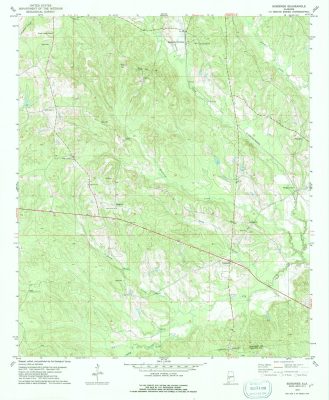 As an important first step, food crop producers should assess the topography of the land for its suitability for growing food crops. Some areas are prone to frequent flooding and should not be used for food production. In other areas, diversion ditches or berms that would keep the crop safe from floodwaters may be added. The United States Geological Survey has online tools to help identify low lying areas and areas prone to flooding. The USDA NRCS Web Soil Survey provides a flooding frequency map that may also be helpful. Erosion prevention practices, such as installation of vegetative barriers and use of cover crops, can be put in place to reduce soil erosion during floods.
As an important first step, food crop producers should assess the topography of the land for its suitability for growing food crops. Some areas are prone to frequent flooding and should not be used for food production. In other areas, diversion ditches or berms that would keep the crop safe from floodwaters may be added. The United States Geological Survey has online tools to help identify low lying areas and areas prone to flooding. The USDA NRCS Web Soil Survey provides a flooding frequency map that may also be helpful. Erosion prevention practices, such as installation of vegetative barriers and use of cover crops, can be put in place to reduce soil erosion during floods.
Producers staying on the farm during a storm will need to make sure they have enough supplies for themselves as well as livestock. During a major storm, it can be expected that power will be out and access to supplies and feed may be limited for extended periods. One of the lessons learned from Hurricane Maria that affected the Puerto Rican islands in 2017 was that power outages and infrastructure can be affected for months in some rural areas. A month after Maria made landfall less than 20 percent of Puerto Rican residents had power restored. The Department of Homeland Security has general information on preparing for storms, including a disaster preparedness kit. Here are some additional recommendations for farms:
- Test chain saws ahead of the storm, fill with gas, and have extra gas ready.
- Prepare wells and other water sources for potential flooding.
- Have batteries and flashlights ready. Food crop producers should have extra batteries, extra flashlights, and a generator. They will be useful during cleanup and recovery if the electricity is out for an extended period.
- Have tarps, rope, and duct tape on hand.
- Know exactly where gas, electrical, and water cutoffs are. In some cases, emergency personnel may ask for utilities to be turned off ahead of a storm to prevent explosions, electrocutions, and contamination to the water supply.
- Double-check insurance policies and confirm what they are supposed to cover. Take photos to document crops and equipment before the storm.
- Keep a copy of important documents off site or in cloud storage. This information will be essential for filing an insurance claim or applying for federal assistance. Copies of deeds, mortgages, loan information, an organized list of assets, and photographs can be beneficial in speeding up a financial claim.
How can damage from airborne debris be minimized?
The combination of wind and rain frequently cause down trees during a storm. Strong winds can cause trees, branches, and equipment to become projectiles that damage other equipment and buildings. When preparing for a storm it is important to assess the location and security of trees and equipment, especially those surrounding buildings.
- Perform preventive maintenance on buildings and equipment to reduce the likelihood of pieces blowing off and becoming projectiles that damage other buildings and equipment.
- Secure lightweight equipment, such as harvest totes, by putting them inside a storage area, tying them down, or filling them with enough water to keep them from becoming projectiles.
- Prioritize protecting chemicals that could contaminate large areas or waterways if they became damaged and leaked.
- Park equipment away from trees and power lines.
- Trim trees with branches that may fall and damage equipment or buildings.
What resources are available to aid recovery?
Cooperative Extension can help with assessing hazards and developing strategies for mitigating risk. The Southern Center for Food Safety Training, Outreach, and Technical Assistance lists on partners from land grant universities across the southern region who provide outreach to producers. Cooperative Extension employees are many times among the first responders helping to assess damage and speed recovery in the agriculture community.
The FDA is a good resource to use when assessing the safety of food crops. District offices have an emergency after hours answering service to assist with addressing food safety concerns that need immediate attention.
The EPA website contains a wealth of information to aid in water testing, identifying sources of contamination, troubleshooting problems with wells, and recovery after a disaster. The information is especially helpful in situations where it is necessary that the well water is potable.
FDA ORA Field Districts
| Atlanta District | Dallas District | Florida District | New Orleans District |
|---|---|---|---|
| Main Number and Emergency (after hours) Answering Service (404) 253-1169 | Main Number and Emergency (after hours) Answering Service (214) 253-5200 | Main Number and Emergency (after hours) Answering Service (407) 475-4700 | Main Number and Emergency (after hours) Answering Service (615) 366-7801 |
References
- Adams, C., E.C. Witt, J. Wang, D.K. Shaver, D. Summers, Y. Filali-Meknassi, H. Shi, R. Luna, and N. Anderson. 2007. Chemical quality of depositional sediments and associated soils in New Orleans and the Louisiana Peninsula following Hurricane Katrina. Environ. Sci. Technol. 41:3437–3443.
- Alexander, P. D., B.J. Alloway, and A.M. Dourado. 2006. Genotypic variations in the accumulation of Cd, Cu, Pb and Zn exhibited by six commonly grown vegetables. Environmental Pollution. 144:736–745.
- Anon. 2018. Flooding and livestock owners. https:// www.wifss.ucdavis.edu/wp-content/…/delta_fair_ livestock_FINAL_web.pdf. Accessed 1 June 2018.
- Barak, J.D. and A.S. Liang. 2008. Role of soil, crop debris, and a plant pathogen in Salmonella enterica contamination of tomato plants. PLos One. 3:e1657.
- Bihn, E., G. Wall, C. Fisk, M. Humiston, D. Pahl, D. Stoeckel, R. Way, and K. Woods. 2017. Produce Safety Alliance National Curriculum. Version 1.1 Produce Safety Alliance, Cornell University.
- Carpenter, S. 2016. Floods and Organic Producers: Steps to Recovery after a Natural Disaster. Farmers’ Legal Action Group, Inc. http://www.flaginc.org/ wp-content/uploads/2016/11/Flooding-and-Organic- Producers-December-2016.pdf.
- Casteel, M.J., M.D. Sobsey, and J.P. Mueller. 2006. Fecal contamination of agricultural soils before and after hurricane-associated flooding in North Carolina. Journal of Environmental Science and Health Part A. 41:173-184.
- Centers for Disease Control and Prevention (CDC). 2011. Guidance on microbial contamination in previously flooded outdoor areas. Atlanta: U.S. Department of Health and Human Services.
- Centers for Disease Control and Prevention (CDC). 2009. Well siting & potential contaminants. https:// www.cdc.gov/healthywater/drinking/private/wells/ location.html
- Ciszewski, D. 2001. Flood-related changes in heavy metal concentrations within sediments of the Biaa Prisma River. Geomorphology. 40:205–218.
- EPA. 2005. What to Do After the Flood. https://www. epa.gov/sites/production/files/2015-05/documents/ epa816f05021.pdf
- Hardy, S. 2017. http://www.theadvocate.com/baton_ rouge/news/article_db460b8e-faed-11e6-b221- df54f109ba17.html
- Hrdinka, T., O. Novický, E. Hanslík, and M. Rieder. 2012. Possible impacts of floods and droughts on water quality. Journal of Hydro-environment Research, 6(2), 145–150. https://www.sciencedirect. com/science/article/pii/S1570644312000093
- https://www.fda.gov/FoodRecallsOutbreaks Emergencies/Emergencies/ucm112723.htm
- Hurburgh, C. and D. Loy. 2011. https://crops. extension.iastate.edu/cropnews/2011/06/flooding- and-stored-grain
- Hurst, C.J., R.L. Crawford, J.L. Garland, and D.A. Lipson (Eds.). 2007. Manual of environmental microbiology. American Society for Microbiology Press.
- Ingham, B. and S. Ingham. 2016. Safely Using Produce from Flooded Gardens. University of Wisconsin-Extension. https://hort.uwex.edu/articles/ safely-using-produce-flooded-gardens/.
- LGMA. LGMA Metrics—Topic Overview: Flooding. http://107.170.254.152/wp-content/uploads/2015/11/ CALGMA-Flooding-Fact-Sheet.pdf
- National Organic Program (NOP). https://www.ams. usda.gov/about-ams/programs-offices/national- organic-program
- Nkwuda G. Nwonumara & Okechukwu I. Okogwu. 2013. The impact of flooding on water quality, zooplankton composition, density and biomass in Lake Iyieke, Cross River-Floodplain, Southeastern Nigeria, Zoology and Ecology, 23:2, 138–146, DOI: 10.1080/21658005.2013.805015. To link to this article: http://dx.doi.org/10.1080/21658005.2013.805 015.
- Overwash, F. 2014. Natural Resource Conservation Service Conservation Practice Standard. https:// efotg.sc.egov.usda.gov/references/public/MN/ 393mn.pdf.
- Paterson, S. and D. Mackay. 1994. A model of organic chemical uptake by plants from soil and the atmosphere. Environ. Sci. Technol. 28:2259–2266.
- Pavlíčková, J., J. Zbíral, M. Smatanová, P. Habarta, P. Houserová, and V. Kubáň. 2006. Uptake of thallium from naturally contaminated soils into vegetables. Food Additives and Contaminants. 23(05):448–491.
- Pease, P., S. Lecce, P. Gares, and C. Rigsby. 2007. Heavy metal concentrations in sediment deposits on the Tar River floodplain following Hurricane Floyd. 51:1103–1111.
- Provin, T.L., S.E. Feagley, J.L. Pitt, and M.L. McFarland. 2008. Soil Testing Following Flooding, Overland Flow of Waste Waters and other Freshwater Related Disasters. AgriLife Extension Publication SCS-2008-07.
- Riddle, J. 2011. Flooding and Organic Certification. http://www.extension.org/organic_production
- Salvato J., N. Nemerow, F. Agardy. 2003. Environmental Engineering. 5th ed. Hoboken, NJ: John Wiley & Sons, Inc.
- Santhi, C., J.D. Atwood, J. Lewis, S.R. Potter, and R. Srinivasan. 2001. Environmental and economic impacts of reaching and doubling the USDA buffer initiative program on water quality. ASAE Meeting Paper No. 01-2068, St. Joseph, Mich. ASAE.
- Sinigalliano, C.D., M.L. Gidley, T. Shibata, D. Whitman, T.H. Dixon, E. Laws, A. Hou, D. Bachoon, L. Brand, L. Amaral-Zettler, R.J. Gast, G.F. Steward, O.D. Nigro, R. Fujioka, W.Q. Betancourt, G. Vithanage, J. Mathews, L.E. Fleming, H.M. Solo- Gabriele. 2007. Impacts of Hurricanes Katrina and Rita on the microbial landscape of the New Orleans area. Proceedings of National Academy of Sciences. 104 (21) 9029–9034; https://doi.org/10.1073/ pnas.0610552104
- Taylor, J., K.M. Lai, M. Davies, D. Clifton, I. Ridley, and P. Biddulph. 2011. Flood management: prediction of microbial contamination in large-scale floods in urban environments. Environment International. 37(5), 1019–1029.
- Vithanage, J. Mathews, L.E. Fleming, H.M. Solo- Gabriele. 2007. Impacts of Hurricanes Katrina and Rita on the microbial landscape of the New Orleans area. Proceedings of National Academy of Sciences. 104 (21) 9029-9034; https://doi.org/10.1073/ pnas.0610552104
- Ward, J.V., and K. Tockner. 2001. Biodiversity: towards a unifying theme for river ecology. Freshwater Biology, 46(6), 807–820.
- Xian, X. 1989. Effect of chemical forms of cadmium, zinc, and lead in polluted soils on their uptake by cabbage plants. Plant and Soil. 113:257–264.
- Xicohtencatl-Cortes, J., E. Sanchez-Chacon, Z. Saldaña, E. Freer, and J.A. Girón. 2009. Interaction of Escherichia coli O157:H7 with leafy green produce. J. Food Prot. 72:1531–1537.

Revised by Camila Rodrigues, Extension Specialist, Assistant Professor, Horticulture, Auburn University.
Originally written by Kristin Woods, former Extension Specialist, Auburn University; Achyut Adhikari, School of Nutrition and Food Science, Louisiana State University AgCenter; Alejandro Castillo, Department of Animal Science, Texas A&M AgriLife Research; Travis K. Chapin, Institute of Food and Agricultural Sciences, University of Florida; Jason Cleere, Department of Animal Science, Texas A&M AgriLife Extension; Michelle D. Danyluk, Department of Food Science and Human Nutrition, Citrus Research and Education Center, Institute of Food and Agricultural Sciences, University of Florida; Audrey Gamble, Department of Crop, Soil and Environmental Sciences, Alabama Cooperative Extension System, Auburn University; and T. Matthew Taylor, Department of Animal Science, Texas A&M AgriLife Research.
Revised July 2025, Food Safety for Southern U.S. Food Crop Producers After Flooding, ANR-2556

